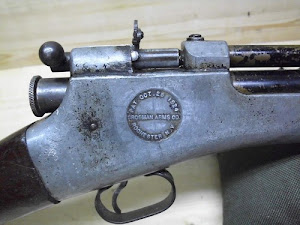There are three variants of the 766, the first version had a tapered plastic barrel housing. The second variant had a tapered metal barrel housing and the third variant had a straight metal barrel housing. The third version was renamed and became the 2100 in 1983.
My rifle is the second variant of the 766. Parts are no longer available from Crosman as they quit making this version of the 766 in 1981. I am ordering parts from the parts list for a late model 2100. A lot of the parts for the 2100 have a 766 prefix, it was nice of Crosman to continue to use the same parts through the years otherwise it would be much more difficult to find the parts I need. There are some differences, most of which seem to be to make production easier and cheaper. I'm not saying the 766 is better than the 2100 just that the 2100 is less expensive to make and the reason you can get a 600+ fps pumper that will put pellets inside a dime at 10 yards for around $60.
There were enough parts to bolt together to make sure it was shootable and it has turned out to be a good shooter so far.
I shot this group at 10 yards, from a bench rest with iron sights. Close to dime sized... not bad.
The missing parts are for the BBs, and the detent that holds the pump arm in the closed position. Being able to shoot BBs isn't important to me but it might be to the next owner so I want to replace them. I replaced the pump seal with a new one and for now the pump arm stays in the closed position.
I cleaned up the valve first, I got lucky and everything looked good and works well. I replaced the O-rings while it was apart.
I used a wooden dowel to push the valve into the pump tube making sure the exhaust port on the valve was lined up with the corresponding hole in the pump tube. The pump got a new pump cup.
I slid the pump into the tube and pressed the pivot pin in place.
Here are the breech, bolt and BB magazine.
The parts assembled and installed in the receiver half, one of the few differences from the 2100 is the screw that holds the breech in place.
The hammer, hammer spring and plug.
Getting all of those pieces assembled and into the receiver half is the most challenging part of this reassembly. It can be very frustrating and take a few tries but it will all fit together, a certain amount of colorful language is required. If you don't cuss, you may start after trying to put one of these back together.
Another difference from the 2100 is the sear, however the trigger is the same for both the 2100 and 766.
Once I get the missing parts I will tear the 766 apart again for a final clean up and reassembly. It is in pretty good shape for a 30 year old air gun.... actually it is in damn good shape for its age.








































